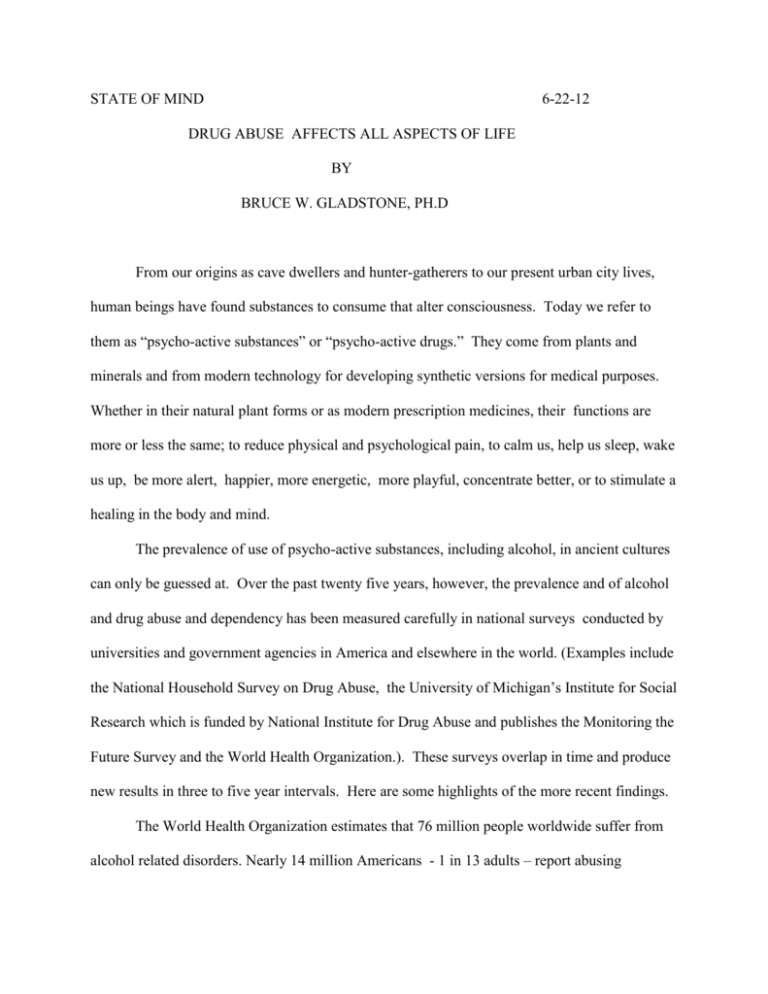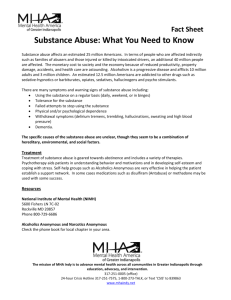STATE OF MIND
advertisement

STATE OF MIND 6-22-12 DRUG ABUSE AFFECTS ALL ASPECTS OF LIFE BY BRUCE W. GLADSTONE, PH.D From our origins as cave dwellers and hunter-gatherers to our present urban city lives, human beings have found substances to consume that alter consciousness. Today we refer to them as “psycho-active substances” or “psycho-active drugs.” They come from plants and minerals and from modern technology for developing synthetic versions for medical purposes. Whether in their natural plant forms or as modern prescription medicines, their functions are more or less the same; to reduce physical and psychological pain, to calm us, help us sleep, wake us up, be more alert, happier, more energetic, more playful, concentrate better, or to stimulate a healing in the body and mind. The prevalence of use of psycho-active substances, including alcohol, in ancient cultures can only be guessed at. Over the past twenty five years, however, the prevalence and of alcohol and drug abuse and dependency has been measured carefully in national surveys conducted by universities and government agencies in America and elsewhere in the world. (Examples include the National Household Survey on Drug Abuse, the University of Michigan’s Institute for Social Research which is funded by National Institute for Drug Abuse and publishes the Monitoring the Future Survey and the World Health Organization.). These surveys overlap in time and produce new results in three to five year intervals. Here are some highlights of the more recent findings. The World Health Organization estimates that 76 million people worldwide suffer from alcohol related disorders. Nearly 14 million Americans - 1 in 13 adults – report abusing 2 or being dependent upon alcohol. In the USA studies show that 53% of adults report having at least one relative who abuses alcohol. One in six families report living with a family member who abuses or depends on alcohol. More than 3 million teenagers in the USA are abusing or dependent on alcohol. The National Association for Adult Children of Alcoholics reported that there are nearly 30 million adult children of alcoholic parents. Nearly 75% of youth 12 to 17 years old cited their parents as the primary influence in their decisions about using alcohol. Abuse of prescription drugs, especially pain killers, tranquilizers and stimulants, is a growing problem. The National Survey on Drug Use and Health in 2010 estimated that 2.4 million Americans used prescriptions drugs without medical reasons for the first time within the past year. More than half of these people were women and one third were kids aged 12 to 17. After alcohol, marijuana and tobacco, prescription medications are the most commonly used by 12th graders. The list of most commonly abused drugs is large and growing. It includes: alcohol, barbiturates (amytal, nembutal, seconal, phenobarbitol), minor tranquilizers ( Valium, Xanax, Ativan, Librium, Hlcion, ), stimulants (amphetamines, methamphetamine, methylphenidate or Ritalin, Adderall, and Dexedrine), hallucinogens (LSD, mescaline, psilocybin, MDA-methylene dioxyamphetamine -, and MDMA - methylene dioxymethamphetamine). Opioids and morphine derivatives – (morphine, heroin, hydrocodone, Vicodin, OxyContin, Codeine, Demerol, Methadone, Fentanyl, and opium, and anabolic-androgenic steroids, and more. The abuse of drugs and alcohol is pervasive throughout the world. No society has immunity to substance abuse. The consequences of substance abuse are devastating and negatively impact every level of human functioning, physically, mentally, emotionally, 3 and socially. Physically, the impact of substance abuse affects every aspect of our functioning in every major organ system in the body. There is widespread acceptance that substance abuse is a “brain disease” involving specific areas of the brain called the midbrain and the limbic system. Scientists are just beginning to describe the complex nature of the interaction of biochemical and neurological pathways and environmental stimulation that are involved with addiction. Some of the more obvious effects of drugs on the body include stimulation or depression of heart rate, blood pressure, respiration, and neural transmission, alterations in blood sugar levels, dehydration, kidney and liver function, reaction time, motor coordination, vision, hearing, sensation, speech and sleep. Prolonged use of alcohol or drugs will increase these effects and may lead to serious tissue damage or organ malfunction. Physical development of fetuses can be profoundly affected by a mother’s alcohol addiction, causing physical deformations and intellectual deficits later in childhood. Mentally, substance abuse can impair thinking, reasoning, memory, language, perception, judgment and learning. The earlier the onset of drug or alcohol use and the more continuous it is, the more serious and long lasting are the resulting mental or cognitive problems. Substance abuse is a major cause of arrested of impaired development in teenagers that may last a life-time. Emotionally, substance abuse impairs development of the capacity for selfregulation, impulse control, self-awareness, awareness of the needs of others, bonding and attachment, communication, ability to empathize and general maturation. While physical 4 development may progress at normal rates despite heavy drug or alcohol consumption in teenage years, emotional development may be arrested at the time or onset of use. Generally speaking people who abuse drugs or alcohol often appear to be emotionally immature, as if their emotional development stopped at about age 14 when they began drinking or using pot. Even adult onset of substance abuse can cause a person to exhibit chronically immature behavior. Socially, substance abuse wreaks havoc on relationships within families, neighborhoods, communities, workplaces, governments, businesses, and throughout society. Families with addicts often live in agony trying to cope with the devastating results of a relative’s addiction. Addicted parents cannot parent their children effectively or sustain a healthy marriage. Substance abusing neighbors disrupt the lives of others in the neighborhood. Addicted coworkers disrupt the work settings. All social organizations suffer directly or indirectly from substance abusing members. The costs in dollars and in human suffering of the abuse of alcohol and drugs is astronomical. Here are a few examples: The dollar cost of alcohol abuse and dependence alone in 2005 was estimated to be $220 billion. Research conducted in 1998 estimated that the dollar cost attributable of underage drinking exceeded $58 billion per year. Fifty percent of homicides are alcohol related. Alcohol abuse is a major factor in the majority of instances of domestic violence. The National Association for Children of Alcoholics estimates that 90% of instances of child abuse are alcohol related. The national Highway Traffic Safety Administration estimates that there are at least 17,000 alcohol related traffic deaths annually. Fifty five percent of Federal prisoners are incarcerated for drug abuse charges. More than 40% of people who begin drinking at age 14 or younger become alcohol dependent. In future issues of State of Mind I’ll write about what we all can do to help reduce substance abuse and its consequences.






